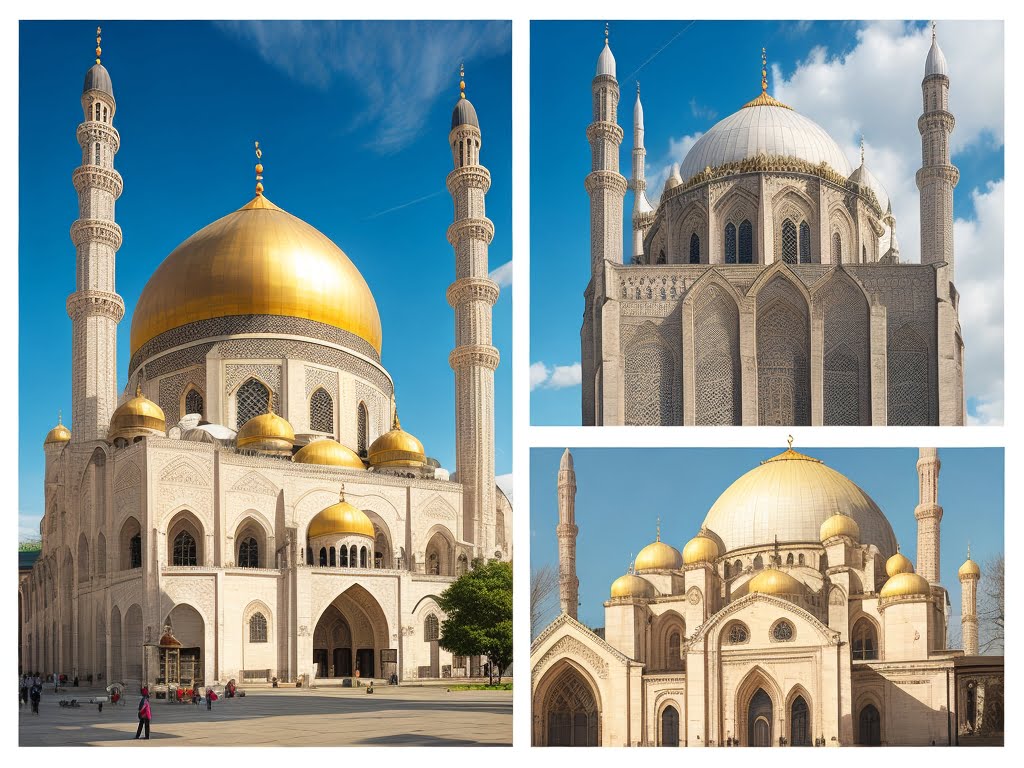Join us on a remarkable adventure as we embark on a journey through the rich tapestry of cruising religious heritage. From the grandeur of majestic cathedrals to the timeless beauty of ancient temples and the serene sanctity of mosques, this exploration promises to be an awe-inspiring experience. It is a chance to delve deep into the heart of different cultures and traditions, offering a unique glimpse into the beliefs that have shaped societies throughout history. So come along, and let the enchanting allure of these sacred sites captivate your senses and enrich your understanding of the world we share.
Table of Contents
ToggleCruising Religious Heritage
Majestic Cathedrals
Gothic Cathedrals: A Marvel of Architecture
Gothic cathedrals are undoubtedly some of the most magnificent architectural wonders in the world. With their soaring height, intricate detailing, and awe-inspiring stained glass windows, these structures are a testament to the creativity and ingenuity of the craftsmen and architects who built them. The Gothic style of architecture, prominent from the 12th to 16th centuries, is characterized by its pointed arches, ribbed vaults, and flying buttresses. As you explore these cathedrals, allow yourself to be transported back in time and marvel at the skill and dedication that went into their construction.
Famous Cathedrals around the World
Around the world, there are countless cathedrals that not only serve as places of worship but also stand as iconic landmarks in their respective cities. One such example is the Notre-Dame Cathedral in Paris, known for its stunning rose windows and Gothic spires. Another renowned cathedral is the St. Peter’s Basilica in Vatican City, the largest church in the world and a symbol of the Catholic faith. From the Cologne Cathedral in Germany to the Duomo di Milano in Italy, each cathedral holds its own unique charm and significance, drawing visitors from all corners of the globe.
Art and Symbolism in Cathedrals
Cathedrals are not merely structures, but living works of art. The walls of these sacred spaces are adorned with intricate paintings, sculptures, and mosaics that serve as visual representations of religious stories and teachings. Every brushstroke and chisel mark tells a story and invites contemplation. The symbolism within cathedrals is equally fascinating, with hidden meanings and allegories embedded in the architecture and artwork. From the depiction of biblical events to the use of specific colors, every element within these cathedrals serves a purpose, making them not only places of worship but also treasure troves of artistic and symbolic significance.
Ancient Temples
The Rich History of Ancient Temples
Ancient temples are a window into the past, offering a glimpse into the religious practices, beliefs, and traditions of ancient civilizations. From the grand temples of ancient Egypt, such as the Great Temple of Abu Simbel, to the sacred sites of the Mayan civilization in Central America, each temple tells a unique story. These temples were not only places of worship but also centers of cultural activities, educational institutions, and gathering spaces for the community. As you explore these ancient sites, you will witness the legacy of ancient civilizations and their enduring impact on the world.
Architectural Styles of Temples
The architectural styles of ancient temples vary greatly depending on the civilization and geography. In ancient Greece, temples were often characterized by their use of the Doric, Ionic, or Corinthian orders, while Hindu temples in India showcased intricate carvings and sculptures as expressions of devotion. In East Asia, Buddhist temples feature pagoda-like structures with graceful curves and delicate details. These architectural styles are a testament to the craftsmanship and artistic sensibilities of the societies that built them. By studying the architectural elements of temples, we unravel not only the religious significance but also the cultural and historical contexts in which they were created.
Significance of Temples in Different Religions
Temples hold a special place in various religious traditions, serving as places of worship, contemplation, and community engagement. In Hinduism, temples are considered the abode of deities, providing devotees with a physical space to connect with divinity. Buddhist temples, on the other hand, serve as sites for meditation, reflection, and the pursuit of spiritual enlightenment. Similarly, in other religions such as Jainism and Sikhism, temples play important roles in facilitating religious rituals, educating believers, and fostering a sense of belonging within the community. These temples, regardless of religious affiliation, serve as vital centers for religious and cultural practices, giving individuals a sense of identity and purpose.
Mosques
Islamic Architecture: The Beauty of Mosques
Islamic architecture is known for its intricate designs, geometric patterns, and harmonious integration of spirituality and aesthetics. At the heart of Islamic architecture lie mosques, which serve as gathering places for Muslims to come together to pray, seek guidance, and strengthen their faith. From the iconic motifs of the Blue Mosque in Istanbul to the elegance of the Sheikh Zayed Grand Mosque in Abu Dhabi, each mosque reflects the cultural and historical influences of the region. The symmetrical domes, minarets, and calligraphy adorning these mosques speak to the rich artistic traditions of the Islamic world, inviting admiration and contemplation.
Iconic Mosques around the Globe
Across continents and countries, there are numerous mosques that have captivated the world with their beauty and historical significance. The Masjid al-Haram in Mecca is the holiest site in Islam, attracting millions of pilgrims each year. The Alhambra in Spain, renowned for its stunning Nasrid architecture, houses the breathtaking court of the Lions, a testament to the Islamic civilization in Andalusia. Other noteworthy examples include the Jama Masjid in Delhi, India, and the Dome of the Rock in Jerusalem, both of which are architectural marvels that have withstood the test of time. These mosques not only fulfill their spiritual role but also serve as beacons of Islamic heritage and cultural identity.
Mosques as Places of Worship and Community
Mosques are not only places of worship but also serve as community centers and educational institutions for Muslims. They provide a space for congregational prayers, religious celebrations, and social gatherings. Mosques often have additional facilities such as libraries, schools, and community halls that cater to the diverse needs of the community. This sense of community fosters a stronger bond among Muslims, promotes social cohesion, and encourages the sharing of knowledge and resources. Mosques stand as pillars of support, unity, and faith, playing an integral role in the lives of Muslims around the world.
Historical Significance of Religious Sites
Religious Conflict and Peaceful Coexistence
Throughout history, religious sites have been both a source of conflict and a place for promoting peace and understanding. Unfortunately, the sanctity of religious sites has often been compromised due to conflicts driven by religious differences. However, amidst these challenges, there have been shining examples of peaceful coexistence and religious tolerance. The Alhambra in Spain, for instance, stands as a testament to the harmonious coexistence of different religious and cultural groups during the Islamic rule in Andalusia. The lessons drawn from these historical episodes remind us of the importance of embracing diversity, promoting dialogue, and fostering mutual respect in our own contemporary societies.
Pilgrimages: Spiritual Journeys to Religious Sites
Pilgrimages have long been an integral part of many religious traditions, providing individuals with an opportunity for spiritual reflection, personal growth, and connection with the divine. From the Hajj pilgrimage to Mecca in Islam to the Kumbh Mela in Hinduism, pilgrimages draw millions of believers from around the world to specific religious sites. These journeys serve as transformative experiences, allowing pilgrims to deepen their faith, seek forgiveness, and find solace in the company of fellow believers. The act of pilgrimage reinforces the significance of religious sites, highlighting their spiritual magnetism and the profound impact they have on the lives of believers.
Preservation Efforts of Religious Heritage
The preservation of religious heritage is of utmost importance in order to safeguard the cultural and historical significance of these sites for future generations. Various organizations, governments, and communities are actively engaged in efforts to restore and conserve religious sites, ensuring their long-term survival. Preservation efforts include architectural restoration, conservation of artworks, and the implementation of sustainable practices to protect these sites from natural disasters and human damage. By preserving religious heritage, we not only honor the past but also provide a platform for dialogue, education, and intercultural exchange, fostering greater understanding and appreciation of the world’s diverse religious traditions.
Art and Sculpture in Religious Sites
Religious Art: Depicting Faith and Stories
religious art within religious sites serves as a visual language through which believers can better understand and express their faith. From the intricate frescoes of the Sistine Chapel in Vatican City to the delicate calligraphy of the Qur’an in Islamic mosques, religious art plays a pivotal role in communicating religious narratives, teachings, and moral values. The stories depicted in religious art allow individuals to connect with the divine, gain a deeper understanding of their own spirituality, and find solace in times of joy or sorrow. Through the mastery of art, religious sites become living testimonies to the power of creativity in conveying the foundations of faith.
Masterpieces of Sculpture in Religious Sites
Sculpture, too, holds a significant presence within religious sites, breathing life into the stories and figures of religious tradition. Whether it be the statues of saints adorning the altars in Catholic cathedrals or the intricately carved stone carvings of deities in Hindu temples, each sculpture tells a unique tale. The craftsmanship and attention to detail in these sculptures are awe-inspiring, conveying not only sacred stories but also the skill and devotion of the artisans who created them. These masterpieces form a vital part of the architectural ensemble, bringing both beauty and spiritual meaning to the religious sites they inhabit.
The Role of Art in Worship
Art has always played a central role in worship, allowing believers to engage their senses and emotions in their spiritual practice. The visual imagery within religious sites serves as a focal point for individuals to concentrate their devotion, guiding them in prayer, contemplation, and meditation. Additionally, art enhances the aesthetic experience of worship, creating a serene and uplifting atmosphere that inspires reverence and introspection. Whether it be the harmonious chorus of a choir in a cathedral or the melodic recitation of sacred verses in a mosque, art and music intertwine to create a transcendent experience, transporting worshipers to a space beyond the physical realm.
Sacred Music and Rituals
Music in Religious Context: Gregorian Chants and Mantras
Music holds a sacred place within religious traditions, serving as a means of spiritual expression, worship, and connection with the divine. In Christian cathedrals, the ethereal sounds of Gregorian chants transport worshipers into a state of deep contemplation and prayer. The sonorous recitation of mantras in Hindu temples creates a meditative atmosphere, drawing individuals closer to their spiritual essence. These sacred sounds evoke emotions, facilitate deep introspection, and unite the congregation in a collective act of devotion. Music in religious contexts serves as a powerful medium through which believers can experience a sense of transcendence and establish a profound connection with their faith.
Rituals and Ceremonies at Religious Sites
Rituals and ceremonies play a fundamental role in religious life, providing structure and a sense of order within religious communities. These practices often take place within the sacred spaces of religious sites, heightening the spiritual significance of the rituals. From the lighting of candles during a Catholic mass to the ablution rituals performed in Islamic mosques, each act holds symbolic meaning and fosters a sense of unity among worshipers. These ceremonies bring individuals together, reinforcing their shared beliefs, and offering a collective experience that strengthens communal ties and faith.
The Importance of Sacred Sounds
Sacred sounds, such as chants, hymns, and recitations, have a profound impact on the worshipers’ spiritual experience. These sounds penetrate deep into the soul, evoking an emotional response and instilling a sense of awe and reverence. The resonance created by these sacred sounds has the power to uplift, heal, and transform individuals’ states of consciousness. Whether it be the resonant tones of church bells, the rhythmic beating of drums during religious processions, or the melodious call to prayer from minarets, the sounds emitted by religious sites serve as a reminder of the ethereal nature of spirituality and its ability to transcend linguistic and cultural barriers.
Influence of Religious Sites on Culture and Society
Religious Festivals: Celebrating Traditions and Faith
Religious festivals provide an opportunity for communities to come together, celebrate their traditions, and reinforce their faith. These celebrations often take place in and around religious sites, amplifying the significance of these locations in shaping cultural identities. From the exuberant festivities of Diwali in Hinduism to the somber processions of Ashura in Islam, religious festivals showcase the rich tapestry of traditions, music, food, and colorful rituals. The influence of religious sites on cultural celebrations deepens the sense of belonging and instills a pride in cultural heritage, fostering community cohesion and promoting intergenerational transmission of traditions.
Architecture’s Influence on Urban Planning
Religious sites, with their grandeur and scale, have often influenced the urban planning and development of cities throughout history. The placement of religious structures within a cityscape often becomes a focal point, determining the layout, orientation, and design of surrounding buildings and infrastructure. Cathedrals, temples, and mosques have served as landmarks and gathering spaces, shaping the identity and character of cities. The architectural styles of religious sites often find their echoes in municipal buildings, public spaces, and residential areas, creating a harmonious aesthetic and cultural integration within the urban fabric.
Religious Sites as Tourist Attractions
Religious sites have long held an allure for travelers and tourists, attracting visitors from all corners of the globe. The architectural grandeur, historical significance, and cultural richness of these sites make them captivating destinations for those seeking spiritual enrichment and cultural exploration. Travelers are drawn to the palpable energy, beauty, and tranquility that these sites offer, as well as the opportunity to learn about different faith traditions and engage in meaningful cultural exchanges. As religious sites become increasingly popular tourist attractions, it is important to strike a balance between preserving their sacred nature and allowing them to be accessible to a diverse range of visitors.
Religious Tolerance and Interfaith Dialogue
Promoting Interfaith Harmony at Religious Sites
Religious sites have the potential to foster interfaith understanding and dialogue by providing spaces for people of different faiths to come together. Interfaith initiatives, such as interfaith prayer services and panel discussions, held within religious sites, create opportunities for individuals to learn about and engage with different religious traditions. By promoting dialogue and mutual respect, these initiatives help break down barriers and build bridges of understanding between people of diverse backgrounds and beliefs. Through interfaith harmony, religious sites become catalysts for peace, social cohesion, and collaboration on issues that transcend religious boundaries.
Lessons in Tolerance from Religious Heritage
The preservation and exploration of religious heritage have much to teach us about the importance of tolerance and respect for different belief systems. By learning from the historical interactions between religious groups, we gain insight into the complexities of coexistence and the power of dialogue in overcoming divisions. The shared histories of religious sites, where different traditions have coexisted and shaped one another, serve as tangible reminders of our common humanity and the inherent interconnectedness of all faiths. These lessons in tolerance from religious heritage can inspire us to embrace diversity, foster understanding, and work towards a more inclusive and harmonious society.
Interactions Between Different Faiths
Religious sites often serve as meeting points for individuals and communities of different faiths, facilitating encounters and interactions that challenge preconceived notions and promote mutual understanding. Shared spaces such as interfaith chapels, prayer halls, and community centers become neutral zones for dialogue and cooperation, where individuals can engage in meaningful conversations and build relationships. These interactions open up avenues for collaboration on shared social issues, such as poverty alleviation, environmental preservation, and promoting human rights. In a world marked by religious diversity, interfaith interactions at religious sites become opportunities for cultivating empathy, compassion, and intercultural understanding.
Spiritual Experiences at Religious Sites
The Power of Spirituality in Religious Spaces
Religious sites hold a spiritual energy that is palpable as soon as you enter their hallowed grounds. The atmosphere is charged with devotion, contemplation, and an intangible sense of the sacred. These spaces offer a respite from the noise and distractions of daily life, allowing individuals to find solace, introspection, and a deep connection with the divine. From the silence of a cathedral nave to the serenity of a temple courtyard, religious sites create an environment conducive to spiritual experiences, helping seekers transcend the mundane and encounter the transcendent.
Personal Reflection and Meditation at Religious Sites
Religious sites provide individuals with the opportunity for personal reflection, meditation, and introspection. Whether it be sitting in quiet contemplation in a meditation hall or walking the labyrinth of a cathedral, these spaces offer a refuge for stillness and self-discovery. Within the sacred confines of religious sites, individuals can seek answers to life’s questions, find solace in times of difficulty, and connect with their inner selves. The spiritual experiences gained through reflection and meditation within these spaces have a profound impact on personal growth, well-being, and the quest for meaning in life.
Seeking Divine Connection
Religious sites are places where individuals seek to connect with the divine, to experience a sense of transcendence and communion with something greater than themselves. Whether through prayer, ritual, or silent contemplation, individuals turn to these sacred spaces to transcend the ordinary and seek a deeper understanding of their place in the universe. The physical and spiritual architecture of religious sites, coupled with the collective energy of worship and devotion, create a conducive environment for seekers to experience moments of divine connection, inner peace, and spiritual fulfillment.
Changing Roles of Religious Sites in Modern Society
Adapting to Modern Needs: Repurposing Religious Buildings
As societal needs evolve over time, the role of religious sites has also adapted to accommodate changing demands. In many instances, religious buildings that have lost their original purpose have found new life through creative repurposing. Abandoned churches have been transformed into concert halls, theaters, and art galleries, breathing new energy into these historic structures. By repurposing religious buildings, we not only preserve their historical and architectural significance but also ensure that these spaces continue to serve as cultural hubs that enrich the lives of communities in contemporary society.
Religious Sites as Cultural Centers
Religious sites have increasingly become more than just places of worship; they have transformed into thriving cultural centers that celebrate diversity and showcase artistic expression. Cathedrals host concerts, choirs, and art exhibitions, while temples provide spaces for dance and music performances. Through these endeavors, religious sites become platforms for cultural exchange, promoting understanding and appreciation of different artistic traditions. The fusion of religious and cultural activities within these sites revitalizes the historical narrative, making them relevant and integral to the fabric of modern society.
Challenges Faced by Religious Institutions
Religious institutions face a myriad of challenges in the modern world, including financial constraints, declining attendance, and generational shifts in religious practice. In an era characterized by rapid globalization and technological advancement, religious institutions must adapt to meet the needs and expectations of the modern individual. Finding innovative ways to engage with diverse communities, embracing social and environmental issues, and fostering a spirit of inclusivity are vital to the continued relevance and sustainability of religious institutions. By addressing these challenges head-on, religious institutions evolve and remain transformative forces in the lives of individuals and communities.
In exploring the diversity of religious heritage, from majestic cathedrals to ancient temples and mosques, we embark on a journey through time, culture, and spirituality. These religious sites are not merely physical structures but testaments to human creativity, devotion, and the timeless quest for meaning. As we traverse the sacred spaces and absorb their beauty, may we embrace the lessons of tolerance, interfaith dialogue, and spiritual exploration that they offer. In doing so, we foster a deeper appreciation for our shared human experience and build bridges of understanding and respect across the diverse tapestry of religious traditions.





